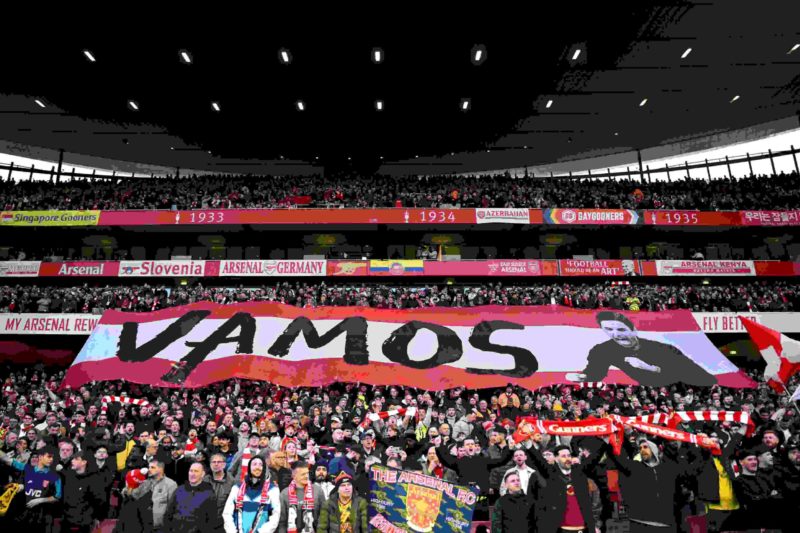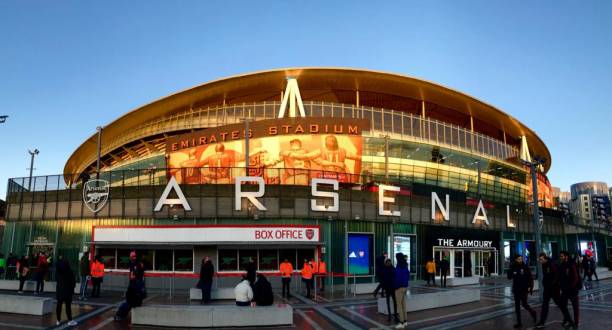Arsenal’s Enterprise Value has seen a remarkable 35.1% annual growth to €3.108 billion, outpacing nearly all top European clubs.
Let’s delve into the factors contributing to Arsenal’s financial success, including player acquisitions, youth development, and the club’s return to the UEFA Champions League.

Arsenal’s financial growth
According to Football Benchmark, Arsenal experienced a 35.1% annual improvement in its Enterprise Value (EV), positioning it significantly ahead of many clubs, including UEFA Champions League finalist Borussia Dortmund, which sits in 11th place, one behind the Gunners. This growth is attributed to Arsenal’s return to the UEFA Champions League and substantial squad enhancements, making Arsenal the second most valuable team as of May 2024.
Arsenal‘s growth is second only to AC Milan‘s 35.5% increase.
Premier League comparison
The Premier League continues to dominate the ranking with nine clubs in the top 32, accounting for 44% of the aggregate EV. Despite losing Leicester City and Wolverhampton Wanderers, the league maintains its strong presence with West Ham, Aston Villa, and Everton also included.
European leagues comparison
In the European context, La Liga holds 21% of the total EV, while Italian clubs and German clubs have comparable aggregate EVs, the top German clubs’ average EV is significantly higher than that of the Italian clubs.
The Portuguese Primeira Liga and Dutch Eredivisie together represent only 3.8% of the top 32’s aggregate EV, highlighting the growing disparity between top leagues and others.
Player trading and youth development
Arsenal‘s strategic player acquisitions include significant deals. In terms of youth development, Arsenal focuses on both internal talent nurturing and signings. Clubs like Chelsea and Real Madrid lead in youth player acquisitions, with substantial investments in young talent.
Profitability and revenue
The overall profitability and revenue growth are significant factors driving the increase in EV among top clubs. Real Madrid, Manchester City, and Manchester United show substantial profitability due to increased matchday and commercial incomes. Arsenal‘s ability to balance cost-cutting measures with on-pitch competitiveness, as seen in their 2023/24 performance, reflects this trend.
Summary
Arsenal‘s remarkable 35.1% growth in EV positions it prominently among both Premier League and European clubs, although they are still behind both Manchester clubs, Liverpool, Spurs, Chelsea, Bayern Munich, PSG, Real Madrid and Barcelona.
While the Premier League dominates with the highest number of clubs in the top 32, European giants like Real Madrid and Bayern Munich lead in overall EV and revenue. Arsenal‘s strategic player signings and return to the UEFA Champions League underpin its significant growth, marking it as a competitive force in both domestic and European football.
What is Enterprise Value (EV)
Enterprise Value (EV) is a comprehensive metric used to assess the total value of a company, including not just its market capitalisation but also its debt and excluding any cash or cash equivalents. EV provides a more accurate representation of a company’s worth by considering all aspects of its capital structure.
Components of Enterprise Value:
- Market Capitalisation:
- The total market value of a company’s outstanding shares of stock. It is calculated by multiplying the current share price by the total number of outstanding shares.
- Total Debt:
- This includes all of a company’s short-term and long-term debt obligations. Debt is an important component because it represents obligations that the company must pay in the future.
- Cash and Cash Equivalents:
- These are assets that can easily be converted into cash. Cash and cash equivalents are subtracted from the sum of market capitalisation and total debt because they can be used to pay off some of the debt, reducing the company’s net cost.
Football Benchmark’s formula:
EV = Market Capitalisation + Total Debt − Cash and Cash Equivalents
Why use Enterprise Value?
- Comprehensive Measure:
- EV provides a more holistic view of a company’s value than market capitalisation alone. It accounts for both equity and debt, offering a clearer picture of the company’s financial health.
- Comparison across companies:
- By including debt and excluding cash, EV allows for a more apples-to-apples comparison between companies with different capital structures. This makes it particularly useful for comparing companies in capital-intensive industries like football clubs.
- Valuation in acquisitions:
- EV is often used in the context of mergers and acquisitions. It represents the amount that would need to be paid to acquire the entire company, including its debt and excluding its cash.
- Indicator of financial leverage:
- EV helps in understanding how much leverage (debt) a company is using. High debt levels compared to equity can indicate potential financial risk.
Application in football clubs:
In the context of football clubs, EV is particularly useful as it includes the value of the squad, stadium, and other sporting infrastructure, along with financial assets and liabilities. This allows for a better assessment of a club’s total value beyond just its revenues and profitability.
For example, in the Football Benchmark report, EV is used to rank and compare the value of different football clubs, taking into account their financial performance, market position, and asset value.
